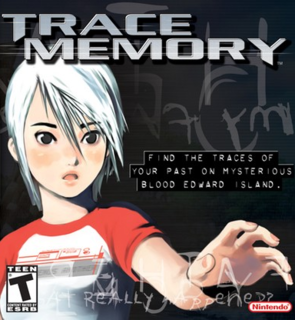Reunioning with one's father may not always be as easy as thought.
A creepy name isn't it? Well, that's only because the island has a rather dark past, but for that I'm not going to tell you any more, because it's part of the essence of the game, to find out the secrets of the island.
Trace Memory is also known as Another Code: Two Memories, and that's the name it's on here in Europe and in the rest of the world besides US. There shouldn't be much difference between these titles, only some minor changes in dialogs and object names.
So, what's the story then? The player controls an almost 14-years old girl called Ashley. At a young age, she was told that both her parents are dead, and her aunt Jessica had to take care of I'm and raise her as her own child. One day, Ashley receives a packet containing a strange device and a letter. A letter from his dad. But what has he been doing on a desolate place like that for eleven years?
Realizing that her father is still alive, she launches her journey with Jessica to meet her father in Blood Edwards Island. The island seems to be more than a desolate place without any trace of living people. But to get to the point, you control Ashley with your touch screen, either showing her the way with your stylus or using the D-pad. You can also interact with objects by taking a closer look with the magnifying class and then double-tap the object you wish to see with your stylus. You can also use the assigned buttons for this, but I preferred the stylus throughout the game, except for controlling Ashley.
Controlling Ashley is quite easy, and it shouldn't be a problem to anyone. When you're about to solve a puzzle, the game transfers you to a separate puzzle screen, where the music is cut off and the graphics are very often changed to 3D. Solving the puzzles are usually very neat because they cleverly use the advantages of DS, like using the mic or doing different movements with your stylus. It has a fresh blow of innovation. Basic Nintendo, I'd say. I like it.
What I really liked in this game, were the 2D graphics. They are very highly detailed, and they're beautifully drawn. They remind of those late SVGA-adventure games for PC. The upper screen of the console is usually used tor showing the room or environment with more details, instead of the overhead-view that is in the touch screen. The characters are very well drawn as well, and the gestures look rather good.
Trace Memory is not the hardest adventure game there is, but it still offered some good problems that required a bit thinking. This game should make you feel "Oh, that's the way to do it!" for quite many times, and that's very good. Keeps up the interest until the very ends of the game.
The only thing that bothered me a bit, is the audio environment. There are not much plain sounds, they are mostly footsteps, that sound good enough. The thing I disliked a bit, is the music. Not that the songs are bad, but they just don't seem to fit the game. The songs have too great a difference between each other, so it makes it sound like it didn't have any particular theme. Almost, but not quite.
The game may be misleading in some points, because there are some puzzles that are actually not even compulsory to be solved, and there are also some items that are completely useless. As far as I understood, you get a slightly different ending if you manage to solve all the problems and find all the memories. Nothing else than that.
I'm sad the game's over already. It didn't take me too many hours in total to play this game through. I would have liked to see a way longer adventure. But, a game is a game, and I sure liked Trace Memory, since good adventure games are rather rare nowadays. If you like puzzle -solving and exploring the environment, you should definitely try this one. It's worth the money.
Oh right. Now I won't forget.

